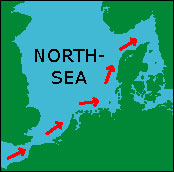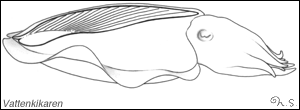|

|
|
Drifted north
The cuttlefish is found from the English
Channel and south along the coasts of Europe and Africa to Mozambique,
and in the Mediterranean. The cuttlefish in the English Channel wander
north into the North Sea during the spring and can wander as far as Scandinavia
during the late summer and early autumn. Its southerly distribution can
be dependant on the fact that it grows only when water temperatures exceed
+10 °C.
Because the skeleton has a lower density than sea water, it
will float on the surface of the water when the cuttlefish dies and drift
over large areas with the currents. In the southern North Sea, the surface
currents follow a northerly direction and follow the coasts of the Benelux
countries, the German Bite, Denmark and into the Skagerrak.
The skeletons are found all along the beaches around the Skagerrak and
Kattegatt.

Cuttlefish live in coastal waters, shallower than 150 m. Reproduction
occurs around 10 m, but they pass the winter in deeper water. They can
be between 1,5-2 years old.
Skeleton
It is thought that cuttlefish that lived
several millions of years ago had a heavier shell and were clumsy. During
evolution the skeleton has decreased in density. Most existing cephalapods
have a skeleton that is enclosed in soft tissue or that is absent.
The skeleton in an adult cuttlefish consists of about 100
thin interspaced calcareous plates, 0.5 mm apart. Between these plates
are cavities that the cuttlefish can fill with nitrogen, oxygen or a sea
water like liquid.

|
|
Page
1 of 4
|

|
|